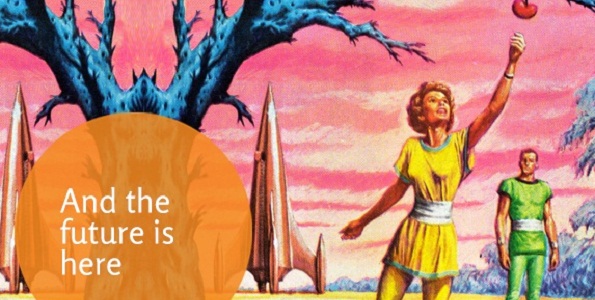And the future is here
One of the most interesting things about working at the cutting edge of technology is seeing how we – human beings that is – deal with artificial intelligence (AI) and the effect it has on our lives.
Human beings have always been fascinated by AI. Think of movies, for example, going back to Fritz Lang’s 1927 classic Metropolis, and later to films such as 2001 A Space Odyssey, Blade Runner, The Matrix, The Terminator…I could go on and on.
The 2016 Oscars are done and dusted. One of my favourite movies of last year, Ex Machina, was nominated for best original screenplay and won for visual effects. It’s about a software engineer chosen to determine the capabilities and consciousness of a beautiful female robot. Soon, however, the programmer realises that the robot is far more self aware and deceptive than anyone imagines. Ex Machina examines the blurred line between AI and humanity. It’s fascinating, so see it if you can.
AI’s moved beyond fantasy and science fiction. In fact, the part it plays in our daily lives, and the way it’s going to affect those lives, is far beyond what anyone could possibly imagine.
I should know. I’ve just got back from the Mobile World Congress (MWC) in Barcelona. MWC’s the world’s biggest and best mobile industry event, attracting over 100,000 delegates from 204 countries, including everyone who’s anyone. At MWC, I learned about the latest tech developments, next generation services and growth strategies in the mobile industry.
All of which I’m bringing home to my company, Springday, and of course to you. So here are three AI trends which in my opinion deserve technology ‘Oscars’. They’re all connected by one overarching development, which is that AI is becoming more and more mobile; and you’ll be seeing all of them later this year.
Predictive wearables: At present, your fitness band tells you how many steps you’ve done and how many you need to do to complete your daily circle. The next generation – think Garmin and Apple – monitor how well you are doing personally and adjust accordingly. For example, if you achieve your movement goals daily your device ups the ante and raises the bar. If you can’t make your daily goals, it adjusts down to suit. And with Garmin, it knows which sport you’re doing and adjusts active calories accordingly.
So your fitness device becomes your personal trainer, giving you constant feedback and spurring you on to continual improvement.
At MWC, by the way, I was Garmin’s guest at a wellness breakfast. They’ve unveiled a fabulous new range of wearable devices, water rated to 50m and with a battery life from a week to a year. I could go on about them for hours but you’ll find more information here.
Wristphones: some of us will wear our phones on our wrist like a watch. I was lucky to be at the launch of the new will.i.am Dial ‘wrist phone’. It operates almost entirely by voice interaction, comes with its own SIM card and connects to Wi-Fi and mobile networks.
The phone’s voice software is powered by an AI assistant called AneedA. You can ask AneedA to book flights, play music – in fact, it becomes your personal offsider. Whilst the demo from Will.I.Am was clunky, the ease with which you can talk to your watch for the answer was cool.
And my last ‘Oscar’ for tech innovation in 2016 goes to…
Virtual reality (VR): Samsung and Facebook have partnered to offer affordable VR headsets and experiences and at MWC I tried out out Samsung’s Oculus VR headset. I sat in a chair in the real world but in the virtual world I was riding a roller coaster, complete with nausea! Wow! Mark Zuckerberg’s dubbed VR one of the most social platforms of the future, so this area is one to keep tabs on. And from a health and wellbeing perspective I see the application of VR in safety learning as being huge.
At a broader level, what do these trends mean, particularly for business and industry? They mean AI will be part of everything we do, and everything has to change to accommodate it. For example, in the health industry, we’re trialling the Australian Government’s e-health system, which will collate medical records and (with customer approval) make them available to health professionals, gym instructors and even third party companies like Springday. Doctors will use smartphones to monitor a patient’s blood pressure or insulin levels. And mobile devices will help elderly people stay independent longer. It is the full circle of the Internet of Things – the IoT.
To quote Kevin Benedict, from the Centre for the Future of Work:
Mobile and sensor technologies are the tip of the spear for digital transformation. They extend our physical senses beyond our physical reach, provide situational awareness and let us take instant action from afar. They allow us to share experiences and gain insights remotely in real-time, not just digitally but also tactilely. They enable globalisation where business, manufacturing, logistics, distribution and customer interactions can move beyond the walls of our offices and into the fields of world markets. These technologies serve to compress time and distance and enable businesses to operate remotely from anywhere…competing in this age will require digital transformation and investments beyond what most companies are anticipating and planning for today. Seven predictions for “Digital” in 2016.
And me? I’m proud to have guided Springday to the cutting edge of this thrilling new world and I’m looking forward to helping people and businesses understand, embrace, and be winners in a mobile, digital future.
What’s going on
Gamification and the future of corporate e-learning: this is the first of four posts by Gal Rimon, on gamification and corporate e-learning. Here he talks about ‘flow’ and the freedoms gamification allows. I’ll bring you his next posts as they come.
What makes a good learning game? A good learning game should do more than teach; it should also satisfy wider organisational goals. This short piece discusses successful learning game characteristics.
Failure to lunch: are you reading this while eating a sando at your desk? Most of us seem to lunch this way now. It’s not great for your health and it does nothing for work satisfaction. Here are some reasons to eat in company.
Digital health news from CES 2016: CES is a technology trade show. Here from this year’s CES is a roundup of digital innovations in the health field. Read about wearable ECG patches, smart belts, and VitalSnap, which allows your smartphone camera to capture and digitise data (including on blood glucose and blood pressure) from non-connected devices.
Knitting’s healthy! Science proves what some of us have known forever. Knitting isn’t just for nanas. Click-clack benefits including diminished chronic pain and strong brain function. Get out those needles before it’s too late.
And men’s knitting – is it the new yoga? Do we detect a trend? Men are switching to knitting to de-stress, to get off smoking – and because they want snazzy jumpers, I guess. Make mine an Aran cardie, thanks.
The robots are coming for Wall Street: in previous newsletters I brought you links to articles about the dangers of new technology. This article describes how automation software is taking over jobs in the financial sector.
Apple vs the FBI – why you should care: have you been following the Apple-FBI stand-off? The FBI wants Apple to create software so it can unlock a terrorist’s phone. Apple’s refuses. This Gizmodo piece stands strongly in the Apple camp.
Why we’re unhappy with work, and how to fix it: nine out of ten workers spend half their waking lives during things they don’t want to do in places they don’t want to be. Research shows why this is, as well as what can improve working lives – and it’s not routine or money.
Rewiring the brain: cutting-edge scientists are reaching past symptoms of mental illness to deal instead with the concrete biology, the biomarkers, underlying those symptoms.
Tech tips
It seems like everything we pay for these days comes with a loyalty card, and of course a different card for each thing, or at least each shop and service.
My purse used to look like, and weigh as much as, a brick – until I saw someone using Stocard. It’s an app, with both Android and Apple versions. You load your loyalty card numbers on it and when you shop, scan your phone or enter the number to get rewards. It also receives catalogues linked to cards.
Don’t mention it.
And another thing
Advice I’d give my 13-year-old self: including ‘don’t’ be afraid to have fun’, ‘waste your money’ and ‘never mention poison to someone on whom you have a crush’. Bittersweet and funny.
21 inspiring quotes from Tony Robbins’ mentor: believe me, they are inspiring, and motivating. I’ve put them on my notice board.
Zumba workout for beginners: oh, go on, give it a shot! In any case, these guys are easy on the optics.










